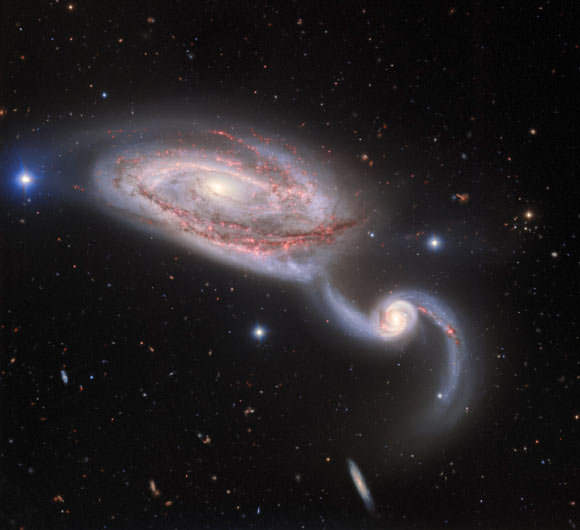Gemini North Telescope Captures Stunning Galaxy Collision | Astronomy – Sci-News.com
Astronomers working at the NSF-supported Gemini Observatory have captured a new photo of interacting spiral galaxies NGC 5394 and NGC 5395, collectively known as Arp 84 or the Heron Galaxy.

This image, taken by the Gemini Multi-Object Spectrograph on the Frederick C. Gillett Gemini North telescope, shows the interacting galaxy pair NGC 5394-NGC 5395. Image credit: NSF’s National Optical-Infrared Astronomy Research Laboratory / Gemini Observatory / AURA.
The NGC 5394-NGC 5395 galaxy pair resides approximately 160 million light-years away in the constellation of Canes Venatici.
The larger member of the pair, NGC 5395, is a near face-on spiral galaxy, with a diameter of 140,000 light-years and a bright central region.
The smaller one, NGC 5394, is barred spiral galaxy. It is about 90,000 light-years across, and has very long spiral arms.
The interacting duo was discovered by the German-born British astronomer William Herschel on May 16, 1787.
“Herschel used his giant 20-foot-long telescope to discover the two galaxies in the same year that he discovered two moons of Uranus,” the Gemini Observatory astronomers said.
“Many stargazers today imagine the two galaxies as a Heron,” they added.
“In this interpretation, the larger galaxy is the bird’s body and the smaller one is its head — with its beak preying upon a fish-like background galaxy.”
The new image of the NGC 5394-NGC 5395 pair was captured using the Gemini Multi-Object Spectrograph (GMOS), an instrument installed on the Frederick C. Gillett Gemini North 8.1-m telescope at the Gemini Observatory on the summit of Mauna Kea, the island of Hawaii.
“The two galaxies have already ‘collided’ at least once,” the astronomers said.
“However, galactic collisions can be a lengthy process of successive gravitational encounters, which over time can morph the galaxies into exotic, yet unrecognizable forms.”
“These galaxies, as in all galactic collisions, are engaged in a ghostly dance as the distances between the stars in each galaxy preclude actual stellar collisions and their overall shapes are deformed only by each galaxy’s gravity.”
“One byproduct of the turbulence caused by the interaction is the coalescence of hydrogen gas into regions of star formation.”
“In this image, these stellar nurseries are revealed in the form of the reddish clumps scattered in a ring-like fashion in the larger galaxy and a few in the smaller galaxy,” they said.
“Also visible is a dusty ring that is seen in silhouette against the backdrop of the larger galaxy.”





